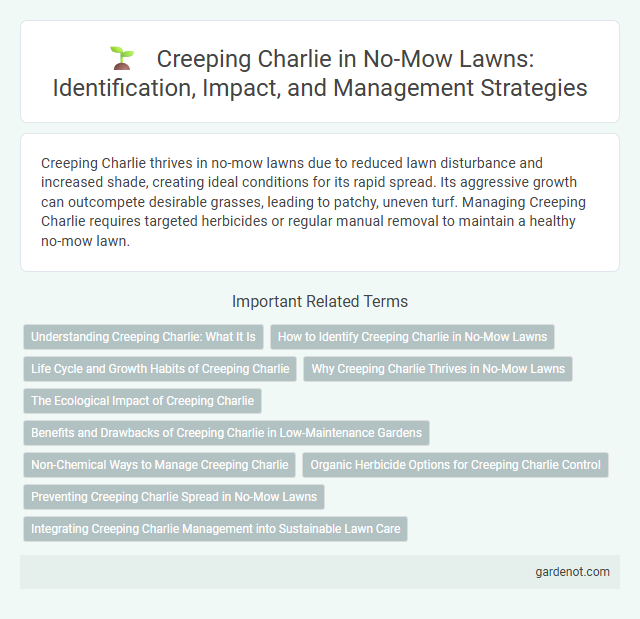Creeping Charlie thrives in no-mow lawns due to reduced lawn disturbance and increased shade, creating ideal conditions for its rapid spread. Its aggressive growth can outcompete desirable grasses, leading to patchy, uneven turf. Managing Creeping Charlie requires targeted herbicides or regular manual removal to maintain a healthy no-mow lawn.
Understanding Creeping Charlie: What It Is
Creeping Charlie (Glechoma hederacea) is a fast-spreading, low-growing perennial weed commonly found in no-mow lawns and shady areas. It thrives in moist, fertile soil and forms dense mats that can outcompete desired grass species. Identification relies on its round, scalloped leaves and purple-blue flowers that bloom in spring.
How to Identify Creeping Charlie in No-Mow Lawns
Creeping Charlie (Glechoma hederacea) in no-mow lawns is identifiable by its round, scalloped leaves and creeping stems that root at nodes, forming dense mats. The plant produces small, tubular purple flowers typically appearing in spring, which distinguish it from other ground covers. Its rapid spreading habit and distinct mint-like aroma also serve as key markers for accurate identification.
Life Cycle and Growth Habits of Creeping Charlie
Creeping Charlie (Glechoma hederacea) is a perennial groundcover characterized by its rapid growth and sprawling stems that root at nodes, allowing it to spread extensively across lawns year-round. Its life cycle involves vigorous vegetative propagation during spring and summer, with small purple flowers appearing in early spring, followed by seed production. This resilient weed thrives in shaded, moist environments and can quickly dominate no-mow lawns due to its aggressive creeping growth habit and ability to regenerate after cutting.
Why Creeping Charlie Thrives in No-Mow Lawns
Creeping Charlie thrives in no-mow lawns due to the lack of regular mowing, which allows it to spread unchecked across the turf. The low maintenance environment provides optimal conditions for its vigorous growth and creeping stems to root at nodes, enabling rapid colonization. These unmowed areas often have increased soil moisture and shade, further supporting Creeping Charlie's preference for moist, shaded habitats.
The Ecological Impact of Creeping Charlie
Creeping Charlie (Glechoma hederacea) disrupts native plant biodiversity by aggressively outcompeting local flora, leading to decreased ecosystem resilience. Its dense mats reduce soil aeration and alter nutrient cycling, negatively affecting soil health and microbial communities. The plant's invasive nature also diminishes habitat quality for native pollinators and wildlife, further impacting ecological balance.
Benefits and Drawbacks of Creeping Charlie in Low-Maintenance Gardens
Creeping Charlie offers dense ground cover that suppresses weeds and reduces soil erosion, making it beneficial for low-maintenance gardens. Its fast-growing nature requires minimal mowing and watering, aiding in water conservation and time savings. However, its invasive tendency can overwhelm other plants and demand occasional control to prevent garden imbalance.
Non-Chemical Ways to Manage Creeping Charlie
Creeping Charlie can be effectively managed in a no-mow lawn by improving lawn health through aeration and overseeding with competitive grasses like fescue and ryegrass, which naturally suppress its growth. Hand-pulling or using a garden knife to remove the plant before it sets seed minimizes spread without chemicals. Applying organic mulches or corn gluten meal also inhibits seed germination and promotes a robust, weed-resistant lawn.
Organic Herbicide Options for Creeping Charlie Control
Organic herbicides such as vinegar-based solutions and corn gluten meal offer effective Creeping Charlie control by targeting its growth without harming beneficial lawn grasses or soil health. Applying a mixture of white vinegar, salt, and a small amount of dish soap during early morning hours enhances the organic treatment's efficacy in weakening and eventually eradicating Creeping Charlie patches. Regular, targeted applications combined with lawn maintenance techniques like proper mowing height and aeration improve organic herbicide performance in sustainable no-mow lawn management.
Preventing Creeping Charlie Spread in No-Mow Lawns
Preventing Creeping Charlie spread in no-mow lawns requires consistent monitoring and targeted treatments such as spot-applying herbicides containing triclopyr or using natural remedies like vinegar-based solutions. Maintaining healthy, dense grass through proper fertilization and adequate watering minimizes open spaces where Creeping Charlie can establish. Regular physical removal by hand-pulling before the weed sets seeds also limits its proliferation without disturbing the lawn ecosystem.
Integrating Creeping Charlie Management into Sustainable Lawn Care
Integrating Creeping Charlie management into sustainable lawn care involves using organic herbicides, promoting dense grass growth, and enhancing soil health to naturally suppress this invasive weed. Employing regular mowing tailored to weaken Creeping Charlie while avoiding excessive lawn stress supports ecological balance and reduces chemical dependency. Combining these methods fosters a resilient, no-mow lawn that maintains aesthetic appeal and environmental sustainability.
Creeping charlie Infographic

 gardenot.com
gardenot.com